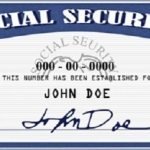A major untapped resource for those researching their family members is the information available from the Social Security Death Index

This index is kept up-to-date by the S. S. Administration office, so long as a person’s death is reported. If you located an error on the index and you have the proof, like the death certificate with the correct death date, do notify the local Social Security office. They will then make the correction and so benefiting future genealogists in their search.
If you do not find a specific relative’s name perhaps they were self-employed or never applied for a social security card. In the early years of the late 1930s and 1940s, it was not required, especially if a person was not working for someone else.
There are several online sites where you can view the SSDI:
- If you have the fee-based Ancestry.com the site with some 91 million listings for the Social Security Death Index. Also the Social Security Applications and Claims Index, 1936-2007 database picks up where the Social Security Death Index (SSDI) leaves off by providing more details than those included in the SSDI. It includes information filed with the Social Security Administration through the application or claims process, including valuable details such as birth date, birth place, and parents’ names. While you will not find everybody who is listed in the SSDI in this database, data has been extracted for more than 49 million people.
- There is Fold3 SSDI site which is free for searching their SSDI listings of some 80 million.
- The FamilySearch.org SSDI free site has 91 million social security listings.
- You can use the free GenealogyBank.com with its 90 million listings.
- Or at Mocavo web site also has a free SSDI index.
Having a copy of your ancestor’s social security application can provide a wealth of information. There will be an applicant’s full name, a woman’s maiden name, date / place of birth, parents’ full names, the individual’s sex and race, their residence when the application was originally filled out and name / address of the applicant’s employer. Since this was a very important vital government record it is less likely there was any fibbing about names and dates, so a good documentation for your files.

The online site for SSA contains the SS-5 Form. The form would be completed and mailed to the Social Security Administration, OEO FOIA Workgroup, P.O. Box 33022, Baltimore, Maryland 21290-3022. Mark both the envelope and its contents: “FREEDOM OF INFORMATION REQUEST.”
Social Security in the United States was signed into law in 1935, so over the last 80 years, there can be additional bits of information to be learned on your ancestors just by checking the SSDI and getting a copy of the application.

Link exchange is nothing else however it is simply placing the other person’s webpage link on your page at suitable place and other person will also do similar in favor of you.|